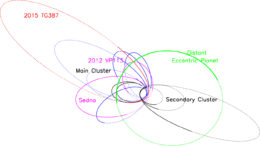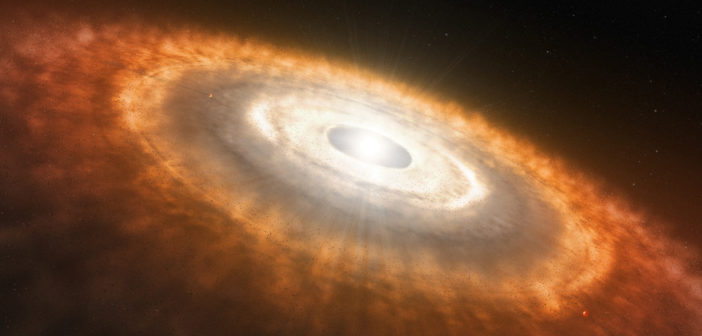The solar system extends well beyond Pluto, encompassing small objects on their own unusual orbits around the Sun. How did they get there? A new study attempts to answer this question with simulations.
Models and Moving Objects
The largest objects in the solar system wield the most influence. Models that account for the Sun and the outer planets — Jupiter, Saturn, Uranus, and Neptune — can produce realistic approximations of the solar system’s overall gravitational influence.
So if you have a model of the major gravitational forces at play, you can drop in orbiting objects and see what they do over time. This sounds simple, but it’s a powerful tool when it comes to understanding the current structure of our solar system.

The evolution of the surface density of the disk with time (starting from the upper-left) as seen face-on (top) and edge-on (bottom). Click to enlarge. Yellow regions have a higher density than blue regions. The timescale P represents 1,000 years. The authors note the “cone” of orbits present prior to t = 4,300 P, as well as the coherent ring of orbits most prominent at t = 9,900 P, which corresponds to an “m = 1 mode”. [Zderic et al. 2020]
A Disk on the Outskirts
The disk being examined by Zderic and collaborators consists of objects orbiting at roughly 100 to 1,000 astronomical units (au) from the Sun. For context, Pluto’s farthest distance from the Sun is just 50 au, so these distances definitely qualify as the outer solar system. The orbits of the disk objects all start off in the same plane (which is also the plane in which the solar system’s planets orbit), but they have a higher than average eccentricity (as conditions in the outer solar system require).
In previous studies with higher mass disks, the disk conditions have been shown to reach a consistent state within 660 million years of simulated time. Zderic and collaborators were interested in this consistent state, which reflects the long-term behavior of the disk. To reach this state more quickly, the authors used an equivalent setup: they started with a less massive disk, and they ran their simulation for just under 10 million years.

Evolution of two orbital parameters for a particular object, specifically eccentricity (y-axis) and the longitude of perihelion (x-axis; the sum of two other orbital properties that sets the orientation of the orbit relative to a plane). Between 5,000 P and 9,000 P, the object under consideration is in the m = 1 mode. [Zderic et al. 2020]
Modes in Models
As the disk of objects evolves, the authors show that the collective gravity of the small bodies can induce an instability. As a result, the final state of the disk has a significant feature: orbits appear to cluster in a particular region. This is called being in a “mode”, which is shorthand for a group of orbital parameters having specific values. Zderic and collaborators note that later in the simulation, objects tend to settle into the m = 1 mode, though objects also fall in and out of the mode. Additionally, adding more particles to the simulation shows that objects stay in the mode longer. Extrapolating to the solar system, the mode may be stable for as long as the solar system is around.
Why is this interesting? These simulations show that the collective gravity of small bodies in a disk can naturally reproduce many of the observed behaviors of objects in our outer solar system — including extreme trans-Neptunian objects (TNOs), small bodies beyond the orbit of Neptune that are on very unusual orbits.

Schematic showing the observed alignment of the orbits of detached extreme TNOs and the proposed orbit of a hypothetical super-Earth-mass planet (in green). But is Planet Nine actually necessary to explain the extreme TNO orbits? [Sheppard et al. 2019]
Further work will require the simulation of high mass disks that are more similar to the early solar system. Keep an eye out for future studies exploring the cause of our solar system’s structure!
Citation
“Apsidal Clustering following the Inclination Instability,” Alexander Zderic et al 2020 ApJL 895 L27. doi:10.3847/2041-8213/ab91a0


1 Comment
Pingback: From AAS NOVA: “Orbits Evolving Under Gravity” | sciencesprings